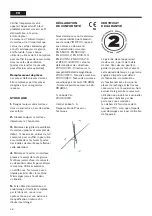
18
EN
e)
Handle the tools carefully.
Check alignment of moving
parts. Make sure that no part
is broken. Control assembling
and any other element that may
affect the operation of the tool.
If any damaged parts please
repair your tool before using.
Many accidents are due to poor
maintenance of the tools.
f)
Please observe these safety
instructions when using your
tool, accessories, etc. taking
into account the specifics of the
device, the workspace and the
work to make.
To avoid dangerous
situations, use your power tool only
for work for which they are suited.
– reParationS
a)
Any repair must be performed
by a qualified technician using
original replacement parts.
Thus you can use your power
tool safely.
2.
PraCtiCal adViCe
For the uSe oF a
deMolition haMMer
Demolition hammer safety
warnings:
a) Use suitable work clothing.
Always make sure to wear boots
or shoes with non-slip soles, sturdy
long pants, and work gloves.
b) Wear ear protective devices
(IMPERATIVE the sound
pressure exceeds 80 dB(A))
while using the hammer.
Exposure to noise can cause
hearing loss.
c) Always wear goggles or some
other eye protection.
d) Use a dust mask to prevent
inhalation of dust.
e) During the engine start and when
running, keep the parts of your
body, especially the hands and feet
away from the chisel.
f) Do not use the hammer on
a ladder, a stepladder or other
surface height.
This hammer is powerful and can
destabilize you. Failure to observe
this information can run a significant
risk of user injury.
g) Your tool features a double
insulation for better protection
against the possible fault isolation
inside your tool.
h) Always use the auxiliary handle
supplied with the tool.
The loss of control may cause injury.
i) Always check walls and ceilings
to see if there are hidden cables
and pipes.
j) Ensure that the switch is in the
OFF position (OFF) when you turn
the hammer. Wait until the tool
stops completely before leaving.
k) Always hold the machine with
both hands.
l) Never use damaged or worn
chisels.
m) Make sure that the chisels are
properly tightened before starting
the hammer. If you use the same
chisel for various tasks, check the
secure hold of it in the sleeve.
n) Do not overreach. Keep a proper
positioning and balance at all
moments. An appropriate position
and balance enables better control
of the tool in unexpected situations.
o) In normal use, the machine can
produce vibrations. The screws
can be loosened during work,
thus producing a risk of serious
accidents and injuries. Before use,
check the tightness of the fixing
screws.
p)
Hold the tool by the insulated
gripping surfaces handles when
performing an operation where
the cutting device can contact
a hidden cable or the own power
tool’s power cord.
Contact with a
cable “under tension” can also put
“under tension” exposed metal parts
of the tool and cause an electrical
shock to the user.
3.
StoraGe
and rePair
a) When not using the tool, always
disconnect the plug before any
maintenance, cleaning or changing
accessories. Ensure that the device
is off (switch in the off position)
when connecting the plug.
Store the unit not used in a dry
place and out of reach of children.
b) Use only spare parts
and accessories supplied or
recommended by the manufacturer.
In fact, all operations that are not
specified in this manual should be
entrusted to service workshops
authorized by us.
c) Protect the tool against moisture.
The unit should not be used wet
or in a humid place
4.
CaBle
a) Before use, check for signs
of damage or wear in the power
cord and the extension cord.
b) If the wire is damaged
during use, immediately unplug
the power supply. DO NOT
TOUCH THE CORD BEFORE
DISCONNECTING THE SUPPLY.
c) Do not use the hammer when
the cables are damaged or worn.
If you use an extension cord,
unwind it completely before use.
The sections of cable conductors
are proportional to the power and
length.















































